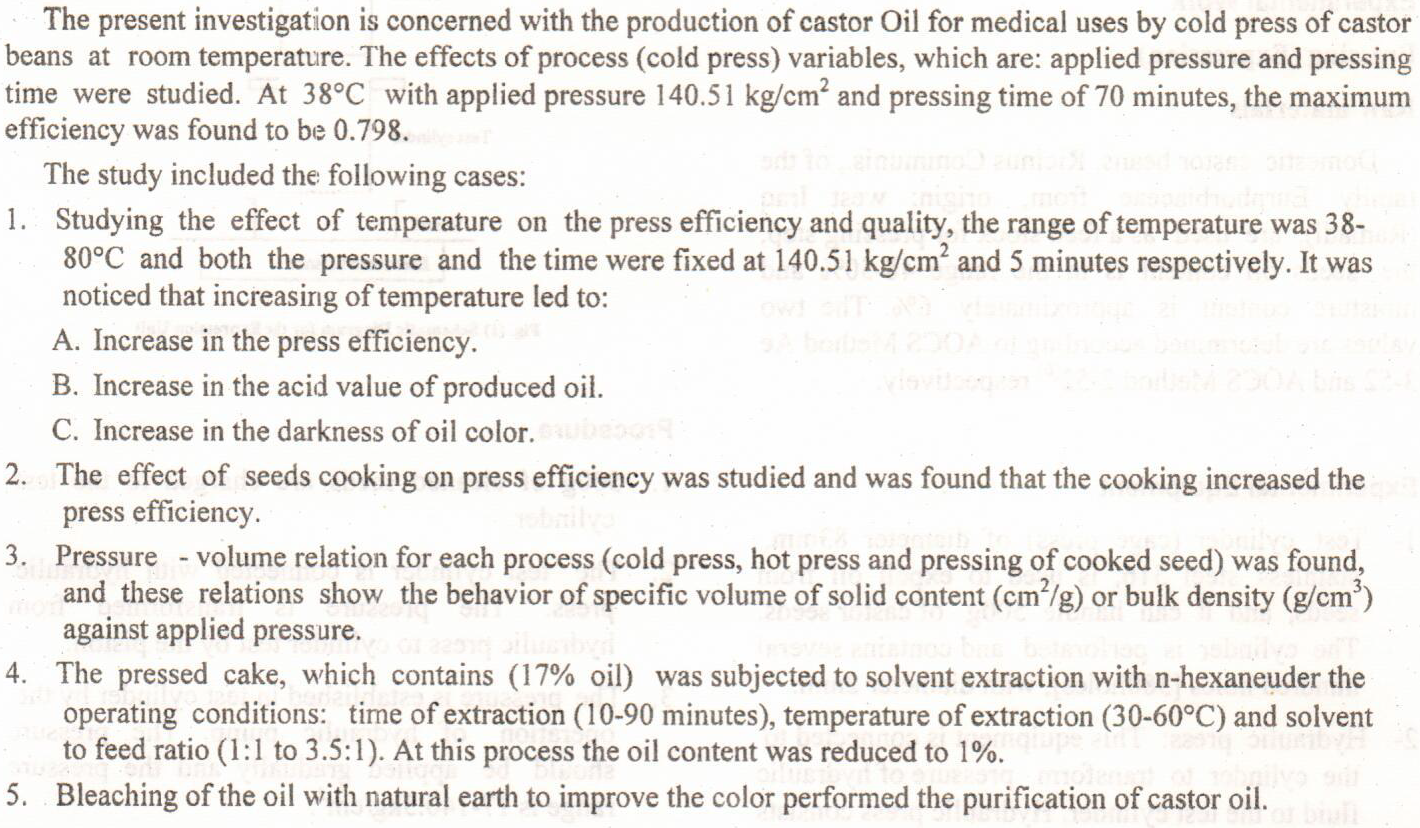
Biodiesel is becoming one of the most attractive alternative biofuels for petroleum-based diesel fuels. The castor plant is one of the abundant non-edible oils found in many countries. This paper aims to study Libyan castor oil and its potential for diesel conversion. Experiments were carried out in the laboratories of the Specific Center for Training in the Oil Industries in Al-Zawiya. The oil was extracted using a Soxhlet extractor and n-hexane solvent at 60 °C. Transesterification reactions were conducted in a batch reactor (a three-neck flask was used, where the middle opening carries a reflux condensation unit) at 65 °C. The methanol-to-castor oil molar ratio was 6:1, with a catalyst concentration of 1 wt.% relative to the ca
... Show MoreThe purified prepared compounds were identified through different methods of identification i.e, I.R, UV-vi^ble-spectroscopy in addition to (coloured tests) Calculation of the sum of OH groups. TLC techniques were also used to test the purity and the speed ofthe rate of flow (RF).
In this work ,medical zinc oxide was produced from zinc scraps instead of traditional method which used for medical applications such as skin diseases, Iraq is importing around 50 ton/year for samarra plant the producted powder has apartical size less than 5 micron and the purity was more than 99.98%,also apilot plant of yield capacitiy 15 kg/8hours wsa designed and manufactured .
Mosquitoes like Culex quinquefasciatus are the primary vector that transmits many causes of diseases such as filariasis, Japanese encephalitis, and West Nile virus, in many countries around the world. The development in the scientific fields, such as nanotechnology, leads to use this technique in control programs of insects including mosquitoes through the use of green synthesis of nanoemulsions based on plant products such as castor oil. Castor oil nanoemulsion was formulated in various ratios comprising of castor oil, ethanol, tween 80, and deionized water by ultrasonication. Thermodynamic assay improved that the formula of (10 ml) of castor oil, ethanol (5ml), tween 80 (14 ml) and deionized water (71ml) was mor
... Show More (7)
(7)
 (3)
(3)
The emergence of oil fields and subsequent changes in adjacent land use are known to affect settlements and communities. Everywhere the industry emerges, there is little understanding about the impact of oil fields on land use in the surrounding areas. The oil industry in Iraq is one of the most important industries and is almost the main industry in the Iraqi economic sector, and it is very clear that this industry is spread over large areas, and at the same time adjoins with population communities linked to it developmentally.
The rapid development and expansion of oil extraction activities in various regions has led to many challenges related to land-use planning and management. Here, the problem of research arises on th
... Show More (5)
(5)
This presented study is to make comparison of cross sections to produce 71As, 72As, 73As and 74As via different reactions with particle incident energy up to 60 MeV of alpha 100 MeV of proton as a part of systematic studies on particle-induced activations on enriched Ge, Ga, Rb and Nb targets and neutron capture. Theoretical calculation of production yield, and suggestion of optimum reaction to produce 71As, 72As, 73As and 74As, based on the main published and approved experimental results of excitation functions were calculated.
This study investigates the application of hydraulic acid fracturing to enhance oil production in the Mishrif Formation of the Al-Fakkah oilfield due to declining flow rates and wellhead pressures resulting from asphaltene deposition and inadequate permeability. Implementing acid fracturing, an established technique for low-permeability carbonate reserves, was essential due to the inadequacy of prior solvent cleaning and acidizing efforts. The document outlines the protocols established prior to and following the treatment, emphasizing the importance of careful oversight to guarantee safety and efficacy. In the MiniFrac treatment, 150 barrels of #30 cross-linked gel were injected at 25 barrels per minute, followed by an overflush wi
... Show MoreThis study investigates the application of hydraulic acid fracturing to enhance oil production in the Mishrif Formation of the Al-Fakkah oilfield due to declining flow rates and wellhead pressures resulting from asphaltene deposition and inadequate permeability. Implementing acid fracturing, an established technique for low-permeability carbonate reserves, was essential due to the inadequacy of prior solvent cleaning and acidizing efforts. The document outlines the protocols established prior to and following the treatment, emphasizing the importance of careful oversight to guarantee safety and efficacy. In the MiniFrac treatment, 150 barrels of #30 cross-linked gel were injected at 25 barrels per minute, followed by an overflush wi
... Show MoreThe remediation oil production by matrix acidizing method on the well named "X" (for confidential reasons) is scrutinized in this paper. Initial production of 1150 bpd, production index of 2.8 STB/Psi/d and permeability of 150md, in 2018 two years down the lane this dropped to 450 bpd, production index 0.7 STB/Psi/d. The declined observed on the production index is trouble shouted and after elimination of (no completion damage/perforation damage), the skin is calculated by carrying out a well test (build-up test) whose extrapolation in excel over times gave us a skin of 40.The reservoir heterogeneity, containing >20% of feldspar, carbonates and paraffin’s guided thematrix acidizing design and treatment proposition to remedy thi
... Show More (2)
(2)
